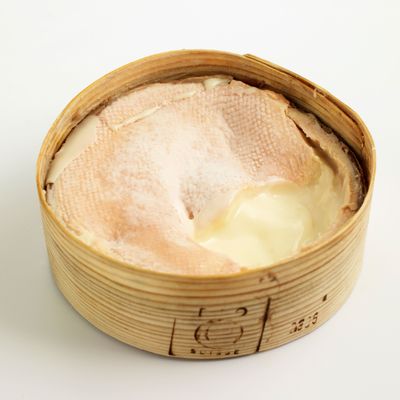
When the year’s first shipment of Vacherin Mont d’Or arrives each fall at Murray’s, one of the country’s preeminent cheese shops, the entire office gathers around a small, single wheel. One person carefully slices off the top, and everyone sticks their spoons into the cheese’s center, which is as soft as pudding. Then the group goes quiet in reverence until someone lets out the first happy moan.
It’s no exaggeration to say that Vacherin Mont d’Or is one of the world’s most-sought-after cheeses. The runny Swiss cheese is only in season from now until the end of winter, and eating it is the kind of funky, perfect experience that cheese nerds wait for all year. It’s also the kind of cheese that can transform a first-timer into a true believer.
“Eating it is akin to losing your virginity,” says Adam Moskowitz, the president of Columbia Cheese, which imports cheese from Switzerland. The cheese hails from the Swiss-French border, near the mountain d’Or. (The craggy mountains, when snow-capped, look straight out of Heidi.) It’s made with winter milk that comes from the same cows that produce Gruyère in the summer. The cows produce less milk in the winter, but that which they do give is richer in fat, which is preferable for small, soft wheels like Vacherin. Its oozing, liquid center is also wrapped in spruce. “It tastes better than the best campfire you have ever been to,” Moskowitz says.
Anne Saxelby, of Saxelby Cheese, agrees. The cheese is pungent, but not overwhelmingly stinky, and, Saxelby says, “breaking through that slightly thick rosy-colored rind to the gooey depths beneath is something that leaves an imprint on whatever part of your brain registers the mathematical outcome of taste multiplied by factors of beauty and pleasure.” Saxelby suggests simply scooping out the interior with a spoon or baguette. Then, “when you think it’s all gone, and the last creamy bits are clinging to the bark, boil some potatoes in salted water and then drop them in the rind and swirl them around to get all the creamy, bark-y goodness stuck to them.”
Like all great delicacies, Vacherin Mont d’Or’s appeal is only amplified by its relative scarcity. The cheese is only available from around October to March, and the best stuff is made with raw milk, which makes it illegal to import (the U.S. bans the importation of cheese made with raw milk that’s been aged less than 60 days). As of now, the cheese is on “FDA import alert with automatic detention,” which Moskowitz explains is “the polite way of saying the cheese cannot enter the Unites States.
What does get into the country tends to move fast. Last year Murray’s gave its regular customers advance notice on the shipment. Wheels sell at $50, and they quickly disappear. (That Vacherin was also made with thermalized milk, a sort of raw-milk compromise where the milk is heated more gently than during pasteurization.)
Brian Keyser, owner of Casellula Cheese and Wine Café and author of Composing the Cheese Plate, remembers a decade ago when “there were only so many great cheeses to be had in the U.S., so when Vacherin Mont d’Or came into season and some wheels of the raw cheese could be smuggled into the country, it was a true delicacy. I remember mongers talking about whether it was worth the risk of breaking the law to sell it.”
Of course, this being America, anything this good, and this scarce, will inspire people to try their hand at making some here, and there are some very exciting alternatives: Uplands Cheese Co. on Pleasant Ridge in Wisconsin makes a killer cheese called Rush Creek Reserve. Like Vacherin, as the cows leave behind the fresh summer pastures and switch to the winter’s hay, they take advantage of the super-rich milk by transforming it into a spruce-bound, silky wheel. Rush Creek is made with raw milk and washed as it ripens, until it oozes with a flavor that’s both meaty and woodsy. Winnimere is another Vacherin Mont d’Or–esque option, made only during winter months when Jasper Hill’s Vermont Ayrshire cows give rich, hay-fed raw milk. Keyser is also particular to Dancing Fern from Sequatchie Cove Creamery in Tennessee, which he calls “earthy, mushroomy, runny, and delicious.”
Even still, it’s worth making friends with a well-connected cheese lover to try and find some of the real thing (or find a well-heeled friend who can smuggle some into the U.S. for you). Shops like Murray’s, Bedford Cheese Shop, and Ideal Cheese tend to have a somewhat reliable supply this time of year, though Keyser warns that many cheesemongers long ago debated whether it was worth facing the consequences of carrying any raw-milk version they might come across. “Most decided that it was not,” he explains, “perhaps selfishly, as they then had to take it home and eat it themselves.”




